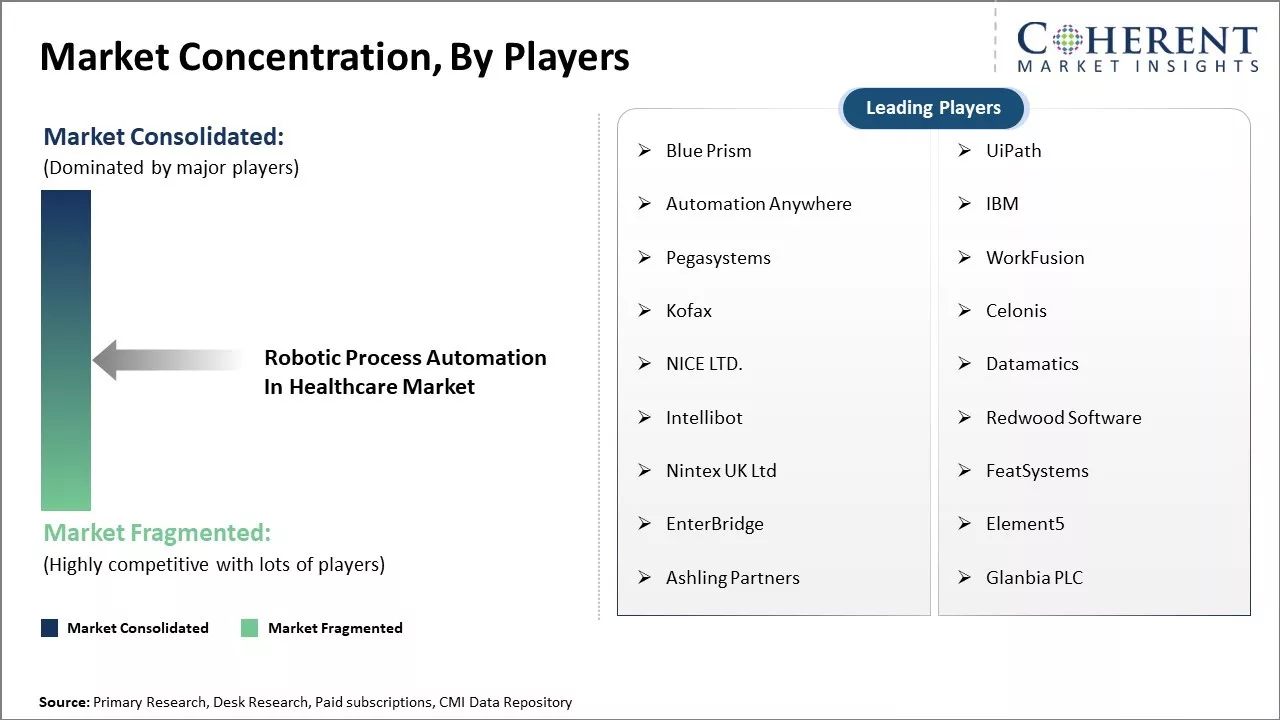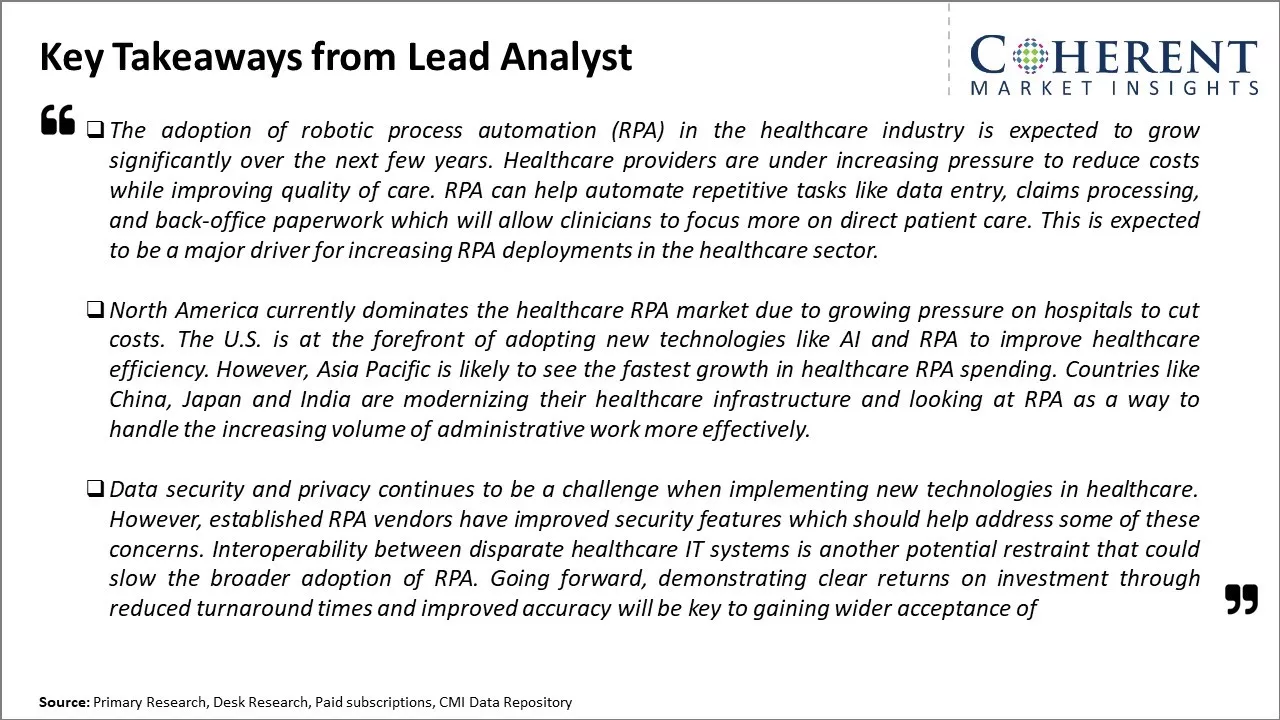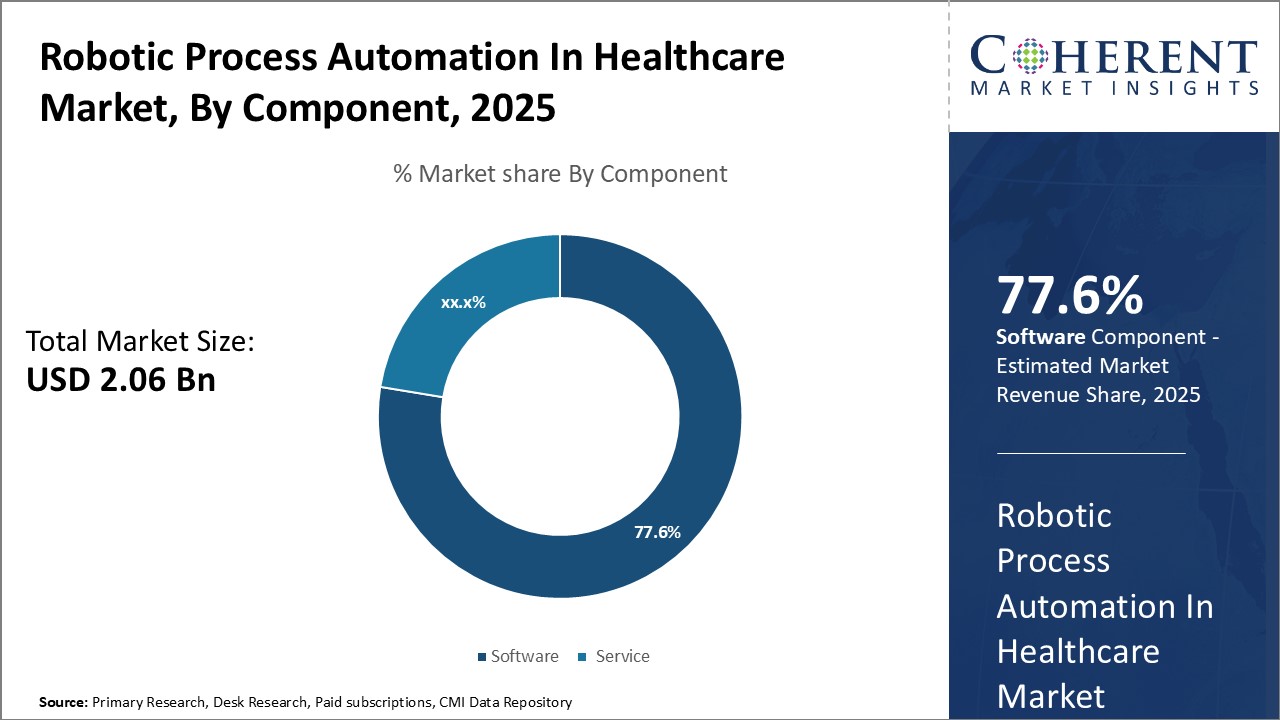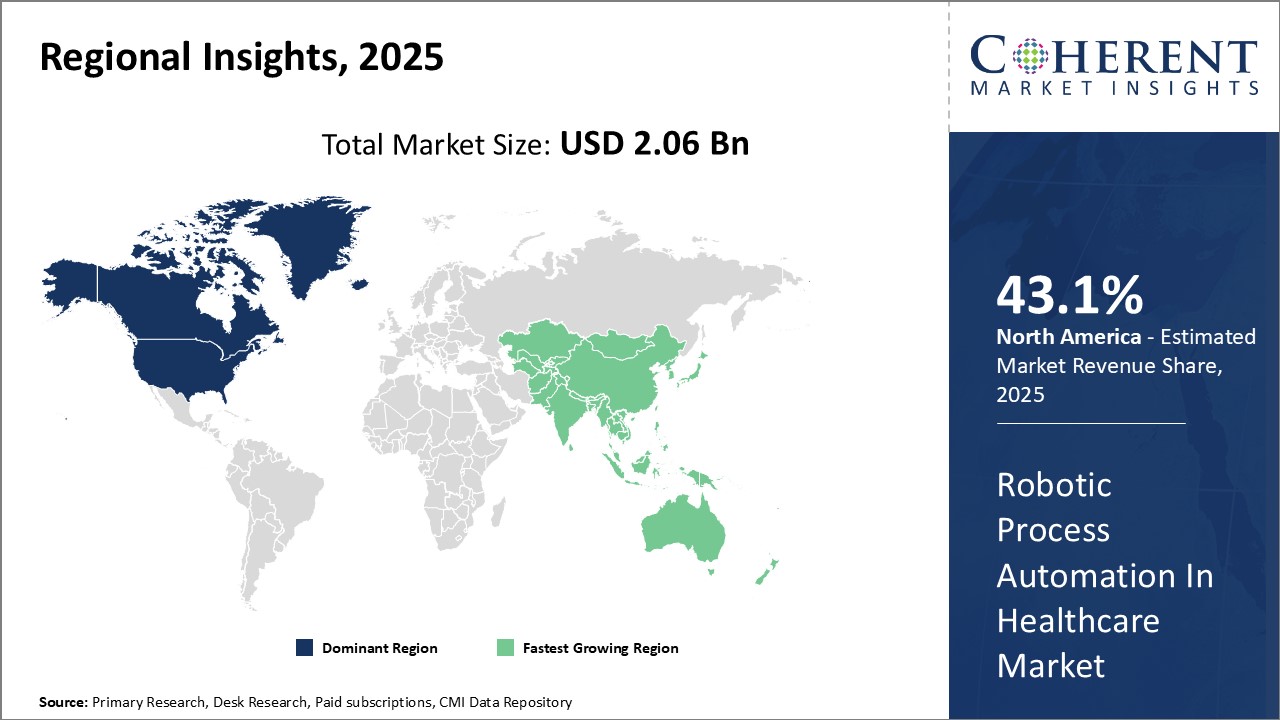The robotic process automation in healthcare Market is estimated to be valued at USD 2.06 Bn in 2025 and is expected to reach USD 6.05 Bn by 2032, exhibiting a compound annual growth rate (CAGR) of 16.6% from 2025 to 2032.

Discover market dynamics shaping the industry: Request sample copy
Robotic Process Automation (RPA) solutions help healthcare providers automate repetitive administrative tasks like data entry, record keeping, and insurance claims processing to reduce costs and human errors. This allows clinical staff to shift their focus toward direct patient care activities. The Robotic process automation in healthcare market is expected to witness significant growth over the forecast period. This is attributed to the rising need for workflow automation and integration of AI-driven solutions in healthcare facilities. Moreover, the increasing demand to minimize healthcare costs and focus on core medical services are propelling the adoption of RPA solutions. However, data privacy concerns and reluctance of healthcare organizations to adopt new technologies may restrain the market during the analysis period.
Growing demand for quality healthcare
The demand for quality healthcare is growing tremendously across the world. With advancing technological capabilities, people expect healthcare services and treatment that is effective and efficient. At the same time, the costs of healthcare are rising rapidly forcing healthcare providers to optimize their workflows and operations. Robotic process automation comes as a solution to address these challenges. By automating repetitive and rule-based tasks, healthcare organizations can free up time for clinicians and staff to focus more on direct patient care activities. This improves the quality of services they can provide. Automation also ensures consistency and standardization in tasks. With robots taking over routine paperwork, documentation and administrative tasks, the scope of human error is reduced leading to enhanced safety and reliability. Further, automation allows healthcare providers to scale up their operations efficiently without increasing the staff strength in direct proportion to the growth in demand. This helps control the operating expenses to some extent.

Get actionable strategies to beat competition: Request sample copy
Lack of healthcare professionalsMost countries across the world are facing an acute shortage of trained healthcare professionals like doctors, nurses and paramedics. This is a severe challenge for providing quality and affordable treatment to an ageing population. Meanwhile, healthcare demands have been rising consistently owing to factors like lifestyle diseases, increased life expectancy and growing patient awareness. The lack of manpower restricts the scope to expand and strengthen healthcare infrastructure as per requirements. This gap in supply and increasing demand is expected to further widen in the coming years. Automation can play a vital role in addressing this lack of human capital in the sector. By automating clinical and administrative workflows that do not necessarily need human expertise, healthcare facilities can redeploy their limited workforce to better utilize their skills. Automating routine tasks will allow clinicians to focus their valuable time on critical areas like direct patient engagement, complex diagnosis and high-risk procedures. This helps leverage existing staff more efficiently and cost-effectively. Ultimately, healthcare access can be improved for more people through optimized utilization of available resources using robotic process automation.

To learn more about this report, Request sample copy
Market Challenges: Stringent data compliance regulationsThe healthcare industry faces several challenges in adopting RPA technology. Healthcare data contains sensitive patient information that must be securely managed and protected according to compliance regulations like Health Insurance Portability and Accountability Act (HIPAA). The diverse and complex nature of healthcare processes makes them difficult to standardize and automate using RPA bots. Healthcare organizations also have rigid IT infrastructure and are often wary of disrupting existing clinical workflows. Overall integration with legacy systems remains a major roadblock for greater RPA adoption.
Market Opportunities: Growing applications of RPA in drug discovery and clinical trials
RPA bots can systematically collect and analyze huge volumes of scientific literature and data from disparate sources to identify potential drug targets and formulations. They can screen thousands of chemical compounds vastly more quickly than humans to identify the most promising leads. This allows researchers to explore more options and bring potential new treatments to patients faster. RPA is also being used to automate workflow tasks across clinical trials like participant enrollment and tracking. Bots can check eligibility criteria for thousands of records nearly instantly, send enrollment emails, book appointments, follow ups, and standardized routine communications. This significantly boosts recruitment efforts and allows trials to be completed ahead of schedule.

Discover high revenue pocket segments and roadmap to it: Request sample copy
Insights, By Component: Growing usage of RPA software to automate repetitive, high-volume clinical and administrative workflowsThe component segment includes software and service. Software segment is estimated to hold 77.6% of the market share in 2025. Healthcare organizations have increasingly turned to RPA software to automate repetitive, high-volume clinical and administrative workflows. This allows clinicians and staff to redirect time and focus toward more complex and meaningful tasks that require human judgement and skills. RPA software emulates the actions of a human interacting within digital systems to complete automated tasks with high accuracy. By integrating with existing clinical systems and data repositories, RPA software is able to extract and input structured data, maintain records, send reminders and notifications, generate reports, and perform other rule-based processes with far greater speed and reliability compared to manual methods. This has helped improve workflow efficiency across revenue cycle management, patient onboarding, billing and claims processing, medical coding, and more clinical areas that involve high transaction volumes.
Insights, By Deployment: Improved access drives growth of the cloud segment
The deployment segment includes on premise and cloud. Cloud contributed the highest share of the robotic process automation in healthcare market and is estimated to hold 73.6% of the market share in 2025. Traditional on-premise RPA requires large upfront investments in hardware infrastructure, ongoing maintenance costs, and dedicated IT resources for administration - barriers that are difficult for many resource-constrained facilities to overcome. Cloud-based RPA, on the other hand, eliminates these issues through a flexible pay-as-you-go pricing structure delivered via the internet. Healthcare providers can access RPA capabilities from any location without worrying about on-site servers, software licenses, patching efforts, capacity planning or other IT hassles. Cloud RPA has seen rapid adoption because it allows for faster deployment times, unlimited scalability to meet fluctuating demand, seamless upgrades to new versions and features, fail-proof business continuity, and centralized management across distributed locations. A cloud platform also supports multi-tenant configurations so different clinical departments, facilities and partners can securely share robots and workflows under a unified architecture.
Insights, By Application: Growing usage of RPA for claims management automation
The application segment includes appointment scheduling, claims management, revenue cycle management, electronic health record (EHR), patient care monitoring, and others. Claims management segment contributed the highest share of the robotic process automation in healthcare market and is estimated to hold 31.8% of the market share in 2025. RPA robots handle the bulk of claims tasks including eligibility verification, fee schedule lookups, claims status updates, data entry from documents, auditing for incomplete forms, notifications to providers and patients, and archiving closed records. By mimicking human actions, RPA achieves high throughput processing thousands of claims per day while eliminating costly errors from repetitive data entry. This helps accelerate reimbursement times, improve cash flow, and reduce cumbersome follow ups and rejected claims. Additionally, RPA uses advanced analytics to uncover anomalies within submitted claims that may require additional human adjudication. It can also anticipate inconsistencies early in the pre-bill stages and flag issues proactively for providers before claims are denied. When integrated with electronic medical records and legacy IT systems, RPA can compile required data across disparate sources to fully complete and digitize claims in standardized formats quickly. Overall, automating the busywork allows staff to focus on higher-value tasks and exceptions while maintaining compliance.

Need a Different Region or Segment? Customize now
North America has dominated the robotic process automation in healthcare market in past decade and is estimated to hold 43.1% of the market share in 2025. The region is home to many leading RPA solution providers and healthcare organizations that are at the forefront of adopting new technologies. The presence of advanced infrastructure and high technology adoption rates among healthcare players in countries like the U.S. and Canada have contributed in the development of North America region. Furthermore, stringent regulations and focus on reducing healthcare costs have driven greater automation needs in the region.
Asia Pacific is anticipated to be the one of the fastest growing regional markets for robotic process automation in healthcare market. Countries like China, India, Japan and South Korea are looking to leverage automation technologies to strengthen their domestic healthcare infrastructure and deal with increasing demands. The availability of skilled resources at competitive costs is enabling greater R&D investments by global RPA vendors in the region. Localization of offerings to support diverse language needs is also helping drive mainstream adoption. Additionally, growing medical tourism and presence of contract manufacturers are contributing new use cases and revenue streams for RPA vendors catering to the Asia Pacific market. With healthcare playing a strategic role in the overall development agenda of many APAC nations, the region's share in the global robotic process automation in healthcare market is projected to grow substantially in the coming years.
Robotic Process Automation In Healthcare Market Report Coverage
| Report Coverage | Details | ||
|---|---|---|---|
| Base Year: | 2024 | Market Size in 2025: | USD 2.06 Bn |
| Historical Data for: | 2020 To 2024 | Forecast Period: | 2025 To 2032 |
| Forecast Period 2025 to 2032 CAGR: | 16.6% | 2032 Value Projection: | USD 6.05 Bn |
| Geographies covered: |
|
||
| Segments covered: |
|
||
| Companies covered: |
Blue Prism, UiPath, Automation Anywhere, IBM, Pegasystems, WorkFusion, Kofax, Celonis, NICE LTD., Datamatics, Intellibot, Redwood Software, Nintex UK Ltd, FeatSystems, EnterBridge, Element5, Ashling Partners, Glanbia PLC |
||
| Growth Drivers: |
|
||
| Restraints & Challenges: |
|
||
Uncover macros and micros vetted on 75+ parameters: Get instant access to report
*Definition: The Robotic Process Automation in Healthcare Market provides robotic technology solutions that help automate repetitive and rule-based healthcare processes. It utilizes software robots or artificial intelligence workers configured to mimic human actions and automate clinical and administrative tasks. This allows healthcare organizations to improve patient services, reduce medical errors, cut costs and boost operational efficiency by automating workflows like data entry, claims processing, making appointments and medical billing.
Share
Share
About Author
Manisha Vibhute is a consultant with over 5 years of experience in market research and consulting. With a strong understanding of market dynamics, Manisha assists clients in developing effective market access strategies. She helps medical device companies navigate pricing, reimbursement, and regulatory pathways to ensure successful product launches.
Missing comfort of reading report in your local language? Find your preferred language :
Transform your Strategy with Exclusive Trending Reports :
Frequently Asked Questions
Joining thousands of companies around the world committed to making the Excellent Business Solutions.
View All Our Clients
US Reciprocal Tax Impact Analysis On Robotic Process Automation In Healthcare Market
Stay updated on tariff changes with expert insights and timely information